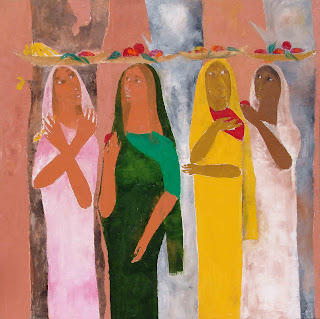Empowering artists to create a sustainable model for livelihood and helping them conserve local folk art traditions.
It is a travesty that folk artists and craftsmen who work laboriously for hours have to struggle to make a living out of it. Ironically, in the process they contribute enormously in keeping local folk art and traditions alive. Folk and tribal arts and crafts are hugely popular with foreign tourists and the urban population, and yet despite their popularity these artisans receive only a small percentage of the sale amount. Commissions by middlemen and prices involved in handling the logistics make a huge dent in the amount which is received by the artists.
This is a story intrinsic to every region and most vernacular art forms. There are only a few folk art forms which are lucrative for the artists and their families, for instance Gond and Madhubani art forms have entered mainstream galleries and with their contemporization, these have become popular as well as acceptable in higher price brackets. However, not all artists benefit even in these cases.
A social initiative #DoRight draws attention to artists from Raghurajpur – ‘a heritage arts & crafts village where every villager is an artist, and every home is an artist’s studio’. The village is famous for its master Pattachitra painters, an art form which dates back to 5the century BC. In fact, the families in this village practice various forms of traditional Odisha art, such as Pattachitra, tal chitra, silk painting, stone carving, coconut painting, betel nut painting, papier mache & masks, cowdung toys and ganjappa playing cards. Their artworks draw inspiration from mythology, religion and folklore.
Following an intensive process, these artists prepare the ‘patta’ – material which is made to look like leaves and natural colours; they then outline the design and fill it with vibrant colours. Each artwork can take anywhere from 5 to 15 days and sometimes even longer, maybe even months. Based on the level of detail, intricacy, finesse and the size of the paintings the prices vary anywhere from Rs 500 to 2 lakhs.
As this village enjoys a heritage status (in the year 2000 by INTACH) it does bring in many domestic and international tourists who buy paintings directly from them which benefits them immediately. However as this does not happen on a continuous basis and there are often middlemen involved, there is a huge disparity in the amount which the artists receive through the year.
So, here’s hoping that they soon succeed in their endeavors and are able to create a successful model which can sustain the artists' existence and also their art!
Related Posts,
GOND ART: To Empower Rural Children
GOND ART: Jangarh Singh Shyam’s Legacy
MANDANA ART: Expression of Joy
It is a travesty that folk artists and craftsmen who work laboriously for hours have to struggle to make a living out of it. Ironically, in the process they contribute enormously in keeping local folk art and traditions alive. Folk and tribal arts and crafts are hugely popular with foreign tourists and the urban population, and yet despite their popularity these artisans receive only a small percentage of the sale amount. Commissions by middlemen and prices involved in handling the logistics make a huge dent in the amount which is received by the artists.
This is a story intrinsic to every region and most vernacular art forms. There are only a few folk art forms which are lucrative for the artists and their families, for instance Gond and Madhubani art forms have entered mainstream galleries and with their contemporization, these have become popular as well as acceptable in higher price brackets. However, not all artists benefit even in these cases.
A social initiative #DoRight draws attention to artists from Raghurajpur – ‘a heritage arts & crafts village where every villager is an artist, and every home is an artist’s studio’. The village is famous for its master Pattachitra painters, an art form which dates back to 5the century BC. In fact, the families in this village practice various forms of traditional Odisha art, such as Pattachitra, tal chitra, silk painting, stone carving, coconut painting, betel nut painting, papier mache & masks, cowdung toys and ganjappa playing cards. Their artworks draw inspiration from mythology, religion and folklore.
Following an intensive process, these artists prepare the ‘patta’ – material which is made to look like leaves and natural colours; they then outline the design and fill it with vibrant colours. Each artwork can take anywhere from 5 to 15 days and sometimes even longer, maybe even months. Based on the level of detail, intricacy, finesse and the size of the paintings the prices vary anywhere from Rs 500 to 2 lakhs.
As this village enjoys a heritage status (in the year 2000 by INTACH) it does bring in many domestic and international tourists who buy paintings directly from them which benefits them immediately. However as this does not happen on a continuous basis and there are often middlemen involved, there is a huge disparity in the amount which the artists receive through the year.
In an effort to empower themselves the artists plan to sell the artworks directly to the customer through a dedicated website, which they hope to set up as soon as they can raise enough funds with our help. The #DoRight initiative has the potential to have a ripple effect and inspire other communities of folk artists also, so they can aim for self-sufficiency and not depend on middlemen for their income.
So, here’s hoping that they soon succeed in their endeavors and are able to create a successful model which can sustain the artists' existence and also their art!
Related Posts,
GOND ART: To Empower Rural Children
GOND ART: Jangarh Singh Shyam’s Legacy
MANDANA ART: Expression of Joy
_by_the_artists_of_Raghurajpur.JPG)









 (
(